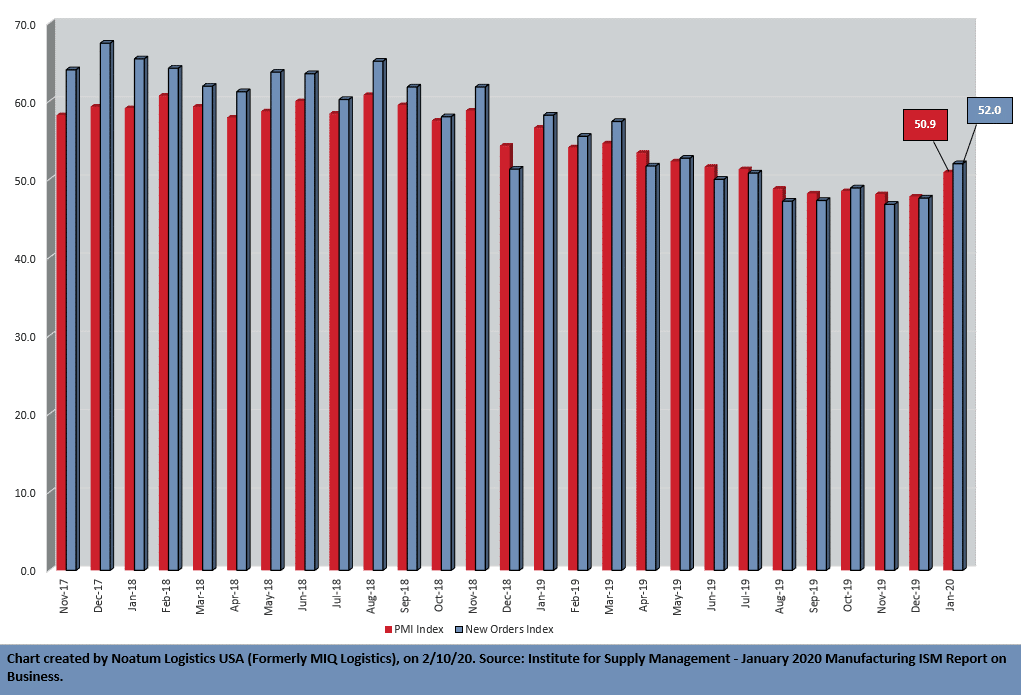Source: Institute for Supply Management – February 3, 2020 Release
Economic activity in the manufacturing sector grew in January, and the overall economy grew for the 129th consecutive month, say the nation’s supply executives in the latest Manufacturing ISM® Report On Business®.

The report was issued today by Timothy R. Fiore, CPSM, C.P.M., Chair of the Institute for Supply Management® (ISM®) Manufacturing Business Survey Committee: “The January PMI® registered 50.9 percent, an increase of 3.1 percentage points from the seasonally adjusted December reading of 47.8 percent. The New Orders Index registered 52 percent, an increase of 4.4 percentage points from the seasonally adjusted December reading of 47.6 percent. The Production Index registered 54.3 percent, up 9.5 percentage points compared to the seasonally adjusted December reading of 44.8 percent. The Backlog of Orders Index registered 45.7 percent, up 2.4 percentage points compared to the December reading of 43.3 percent. The Employment Index registered 46.6 percent, a 1.4-percentage point increase from the seasonally adjusted December reading of 45.2 percent. The not seasonally adjusted Supplier Deliveries Index registered 52.9 percent, a 0.7-percentage point increase from the not seasonally adjusted December reading of 52.2 percent. The Inventories Index registered 48.8 percent, a decrease of 0.4 percentage point from the seasonally adjusted December reading of 49.2 percent. The Prices Index registered 53.3 percent, a 1.6-percentage point increase from the December reading of 51.7 percent. The New Export Orders Index registered 53.3 percent, a 6-percentage point increase from the December reading of 47.3 percent. The Imports Index registered 51.3 percent, a 2.5-percentage point increase from the December reading of 48.8 percent.
“Comments from the panel were positive, with sentiment improving compared to December. The PMI® returned to expansion territory for the first time since July 2019. Demand expanded, with (1) the New Orders Index growing at a moderate rate supported by new export order expansion, (2) the Customers’ Inventories Index remaining at ‘too low’ status and (3) the Backlog of Orders Index contracting for the ninth month, but at a slower rate. Consumption (measured by the Production and Employment Indexes) expanded to respond to new order intake, contributing positively (a combined 10.9-percentage point increase) to the PMI® calculation. Inputs — expressed as supplier deliveries, inventories and imports — weakened in January, due primarily to increasing contraction in inventories while supplier deliveries remained in expansion territory, but at a modest rate. Imports expansion returned, but also at a moderate rate. Inputs contributed negatively to the PMI® calculation, a reversal from the previous month. Prices increased for the second month, a positive for 2020.
“Global trade remains a cross-industry issue, but many respondents were positive for the first time in several months. Among the six big industry sectors, Food, Beverage & Tobacco Products remains the strongest, followed closely by Computer & Electronic Products. Petroleum & Coal Products is the weakest. Overall, sentiment this month is moderately positive regarding near-term growth,” says Fiore.
Of the 18 manufacturing industries, eight reported growth in January — listed in order — are: Furniture & Related Products; Wood Products; Food, Beverage & Tobacco Products; Computer & Electronic Products; Miscellaneous Manufacturing; Nonmetallic Mineral Products; Chemical Products; and Fabricated Metal Products. The eight industries reporting contraction in January — listed in order — are: Printing & Related Support Activities; Apparel, Leather & Allied Products; Electrical Equipment, Appliances & Components; Petroleum & Coal Products; Textile Mills; Transportation Equipment; Primary Metals; and Machinery.
Click here to access the entire release from the Institute for Supply Management website.
